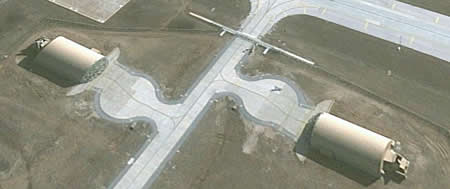10 NATO Countries Want More Transparency for Non-Strategic Nuclear Weapons
 |
| Ten NATO countries recommend increasing transparency of non-strategic nuclear weapons, including numbers and locations at military facilities such as Incirlik Air Base in Turkey. Neither NATO nor Russia currently disclose such information. |
.
By Hans M. Kristensen
Four NATO countries supported by six others have proposed a series of steps that NATO and Russia should take to increase transparency of U.S. and Russian non-strategic nuclear weapons.
The steps are included in a so-called “non-paper” that Germany, the Netherlands, Norway and Poland jointly submitted at the NATO Foreign Affairs Minister meeting in Berlin on 14 April.
Six other NATO allies – Belgium, the Czech Republic, Hungary, Iceland, Luxemburg and Slovenia – also supported the paper.
The four-plus-six group recommend that NATO and Russia:
- Use the NATO-Russia Council (NRC) as the primary framework for transparency and confidence-building efforts concerning tactical nuclear weapons in Europe.
- Exchange information about U.S. and Russian tactical nuclear weapons, including numbers, locations, operational status and command arrangements, as well as level of warhead storage security.
- Agree on a standard reporting formula for tactical nuclear weapons inventories.
- Consider voluntary notifications of movement of tactical nuclear weapons.
- Exchange visits by military officials [presumably to storage locations].
- Exchange conditions and requirements for gradual reductions of tactical nuclear weapons in Europe, including clarifying the number of weapons that have been eliminated and/or stored as a result of the 1991-1992 Presidential Nuclear Initiatives (PNIs).
- Hold a NRC seminar on tactical nuclear weapons in the first quarter of 2012 in Poland.
According to estimates developed by Robert Norris and myself, the United States currently has an inventory of approximately 760 non-strategic nuclear weapons, of which 150-200 bombs are deployed in five European countries. Russia (updated estimate forthcoming soon, previous estimate here) has larger inventory of 3,700-5,400 nonstrategic weapons in central storage, of which an estimated 2,000 are deliverable by nuclear-capable forces.
The proposal comes as the first phase of NATO’s new Defense and Deterrence Posture Review (DDPR) has begun preparation of four so-called scoping papers on 1) the threat facing NATO, 2) the alliance’s strategic mission, 3) the appropriate mix of military forces, and 4) the alliance’s arms control and disarmament policy. The four-plus-six initiative seeks to provide input to the DDPR as well as future work of NATO’s new Weapons of Mass Destruction (WMD) Control and Disarmament Committee. The results of the DDPR are scheduled for approval by the alliance at the summit in March 2012.
Five of the 10 countries supporting the new initiative also were behind an initiative in February 2010 that urged the alliance to include its nuclear policy on the agenda for the NATO meeting in Tallinn in April 2010. The non-paper builds on a previous Polish-Norwegian initiative from April 2010 that is not described.
The Strategic Concept adopted by NATO in November 2010 removed much of the language that previously had identified U.S. non-strategic nuclear weapons in Europe as the trans-Atlantic “glue” in the alliance. Unfortunately, after unilaterally reducing the U.S. weapons in Europe by more than half between 2000 and 2010 and insisting that the deployment was not linked to Russia, NATO reinstated Russia as an official link by concluding in the Strategic Concept that “any” reductions in the U.S. deployment must take into account the disparity with Russian non-strategic nuclear weapons.
The four-plus-six paper does not explicitly call for new cuts and explicitly rejects unilateral reductions. However, it states that transparency and confidence building are “crucial to paving the way for concrete reductions.” To that end the paper is in tune with statements recently made by Gary Samore, Special Assistant to the President and White House Coordinator for Arms Control and Weapons of Mass Destruction, Proliferation, and Terrorism, and by Rose Gottemoeller, Assistant Secretary of State for the Bureau of Arms Control, Verification and Compliance.
I’m an avid supporter of increasing transparency, but given the success of the unilateral Presidential Nuclear Initiatives (PNIs) of 1991-1992 in jumpstarting reductions in non-strategic nuclear weapons without verification, I’m a little concerned about how ready some are to reject unilateral cuts. After all, the United States and NATO have just approved one: retirement of the nuclear Tomahawk land-attack missile (TLAM/N). Rather, transparency, unilateral cuts, and negotiated reductions should all be embraced as tools to move the process forward of reducing the number and role of nuclear weapons.
See: NATO Non-Paper on Non-Strategic Nuclear Weapons
This publication was made possible by a grant from Carnegie Corporation of New York and Ploughshares Fund. The statements made and views expressed are solely the responsibility of the author.
Satellite imagery has long served as a tool for observing on-the-ground activity worldwide, and offers especially valuable insights into the operation, development, and physical features related to nuclear technology.
This report outlines a framework relying on “Cooperative Technical Means” for effective arms control verification based on remote sensing, avoiding on-site inspections but maintaining a level of transparency that allows for immediate detection of changes in nuclear posture or a significant build-up above agreed limits.
The grant comes from the Carnegie Corporation of New York (CCNY) to investigate, alongside The British American Security Information Council (BASIC), the associated impact on nuclear stability.
Satellite imagery of RAF Lakenheath reveals new construction of a security perimeter around ten protective aircraft shelters in the designated nuclear area, the latest measure in a series of upgrades as the base prepares for the ability to store U.S. nuclear weapons.